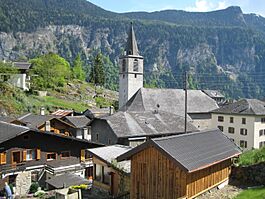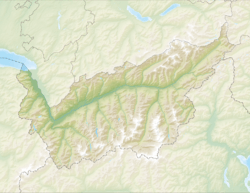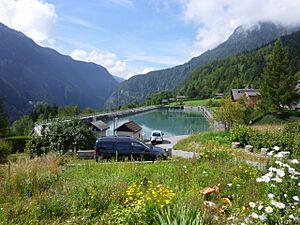Salvan facts for kids
Quick facts for kids
Salvan
|
||
|---|---|---|
 |
||
|
||
| Country | Switzerland | |
| Canton | Valais | |
| District | Saint-Maurice | |
| Area | ||
| • Total | 53.46 km2 (20.64 sq mi) | |
| Elevation | 912 m (2,992 ft) | |
| Population
(Dec 2020 )
|
||
| • Total | 1,442 | |
| • Density | 26.973/km2 (69.861/sq mi) | |
| Postal code |
1922
|
|
| Surrounded by | Evionnaz, Finhaut, Martigny, Martigny-Combe, Sixt-Fer-à-Cheval (FR-74), Trient, Vernayaz | |
Salvan is a town, also called a municipality, located in the Saint-Maurice district. It is in the Valais canton of Switzerland.
Contents
History of Salvan
Salvan was first mentioned in old records in 1018. Back then, it was called cum Silvano. A few years later, around 1025-1031, it was known as in monte Salvano. The town used to have a German name, Scharwang, but this name is not used anymore.
Geography of Salvan
Salvan covers an area of about 53.5 square kilometers (20.7 square miles). A small part, about 7.5%, is used for farming. Forests cover about 25.7% of the land. Buildings and roads take up 1.6% of the area. The remaining 65.2% is land that cannot be used for farming or building.
Location and Hamlets
The municipality is in the Saint-Maurice district, within the Trient Valley. It includes the main village of Salvan. It also has several smaller villages, called hamlets. One of these is Les Marécottes. Until 1912, Vernayaz, Miéville, and Gueuroz were also part of Salvan.
Rivers and Mountains
Salvan's land includes a large part of the Trient river valley. It also has two important side valleys. These are the Vallon d'Emaney and the upper Vallée de Barberine. The artificial lake of Émosson is in the Vallée de Barberine. A small part of Salvan's land is drained by the Salanfe river, which flows into the Rhone river.
Even though Salvan does not have the highest point in the Trient Valley, it has several tall mountains. Some of these are over 3,000 meters (9,800 feet) high. The tallest mountains in Salvan are Tour Sallière and Mont Ruan. Both of these are found in the Vallée de Barberine.
Salvan's Coat of Arms
The coat of arms for Salvan is a shield with a special design. It has a red background. There is a silver (white) pointed shape coming up from the bottom. This shape looks like a hill with a green pine tree on it. In the top right corner, there is a silver cross with round ends. In the top left corner, there is a silver seven-pointed star.
Population and People of Salvan
Salvan has a population of about 1,118 people. As of 2008, about 7.1% of the people living in Salvan were from other countries. Over ten years (2000-2010), the population changed by about 0.6%. This change was mostly due to people moving in (7.1%) and fewer births than deaths (-3.9%).
Languages Spoken
Most people in Salvan speak French. In 2000, about 92.8% of the population spoke French as their main language. German was the second most common language, spoken by about 3.0% of the people. Dutch was third, spoken by 1.0%. A small number of people, 6, spoke Italian.
Where People Come From
In 2008, about 47.4% of the population was male and 52.6% was female. Most people were Swiss citizens. In 2000, about 51.2% of the people living in Salvan were born there. About 15.6% were born in the same canton (Valais). Another 16.5% were born elsewhere in Switzerland. About 13.8% were born outside of Switzerland.
Age Groups in Salvan
In 2000, children and teenagers (ages 0-19) made up 22.5% of the population. Adults (ages 20-64) were 57.4% of the population. Seniors (over 64 years old) made up 20.1%.
Households in Salvan
In 2000, there were 439 private households in Salvan. On average, there were 2.2 people per household. About 163 households had only one person. About 25 households had five or more people. In 2000, about 38.3% of apartments were lived in all year. About 55.0% were used only during certain seasons. The rest, 6.7%, were empty. In 2009, new homes were being built at a rate of 8.1 new homes for every 1000 residents.
Important Heritage Sites
Les Marécottes has a large storage basin for the Swiss Federal Railways. This basin is considered a very important Swiss heritage site. The entire small village of Le Trétien is also part of the list of Swiss Heritage Sites.
Sister Cities
Salvan has "twin town" relationships with two towns in France. These towns are St-Jeannet, Nice, and Saint-Jeannet, Alpes-Maritimes.
Salvan's Economy
In 2010, the unemployment rate in Salvan was 4.6%. This means 4.6% of people looking for work could not find a job.
Jobs and Businesses
In 2008, there were 15 people working in the primary economic sector. This sector includes farming and other raw material jobs. There were 7 businesses in this area. The secondary sector had 29 workers and 11 businesses. This sector includes manufacturing and construction. The tertiary sector had 207 workers and 38 businesses. This sector includes services like hotels, shops, and healthcare.
In 2008, there were 182 full-time equivalent jobs in Salvan. Six of these jobs were in agriculture. Twenty-five jobs were in the secondary sector. Half of these were in manufacturing, and more than half were in construction. There were 151 jobs in the tertiary sector. Many of these were in hotels or restaurants (23.8%). Others were in healthcare (36.4%) or education (4.6%).
Commuting to Work
In 2000, 51 workers came into Salvan for their jobs. However, 262 workers left Salvan to work in other places. This means many more people leave Salvan for work than come in. About 10.8% of working people used public transportation. Most people, 62.6%, used a private car to get to work.
Religion in Salvan
Based on the 2000 census, most people in Salvan were Roman Catholic, about 79.4%. About 8.8% belonged to the Swiss Reformed Church. A small number of people belonged to other Christian churches or other religions. About 6.67% of the population did not belong to any church.
Education in Salvan
In Salvan, about 37.7% of the population has finished non-mandatory upper secondary education. This is like high school. About 10.6% have gone on to higher education. This includes university or a Fachhochschule (a type of professional university).
In 2000, 5 students came to Salvan from other towns for school. However, 83 students from Salvan went to schools outside the municipality.
Salvan has a library called Bibliothèque communale et scolaire. In 2008, the library had over 4,000 books and other media. It loaned out over 7,000 items that year. The library was open 80 days a year, for about 6 hours each week.
Transportation in Salvan
The narrow-gauge Martigny–Châtelard line runs through the eastern part of Salvan. It has four stations within the municipality. These stations are Salvan, Les Marécottes, La Médettaz, and Le Trétien.
Skiing in Les Marécottes
The ski area above Les Marécottes is not very big. It ranges from 1,100 meters (3,600 feet) to 2,200 meters (7,200 feet) high. It has 5 ski lifts: 1 gondola, 1 chairlift, 1 platter lift, and 1 rope tow. There are 25 kilometers (15.5 miles) of ski runs. These runs vary from difficult black slopes like "Le Rec" to easy blue slopes like "Le Perron."
Les Marécottes is part of "Ski Super St. Bernard." This is a group of several smaller ski resorts in the Martigny-St. Bernard area. They all share one ski pass. Other villages in this group include La Fouly, Champex, Vichères, Bruson, and Super St. Bernard (which is now closed). Les Marécottes is special because it owns its own lifts. The other resorts were bought by Téléverbier, which runs the Verbier ski lifts.
The ski lifts in the Marécottes-La Creusaz area used to be quite old. But in the summer of 2012, new lifts were installed. A new detachable chairlift and a new platter lift replaced the older ones.
See also
 In Spanish: Salvan para niños
In Spanish: Salvan para niños







